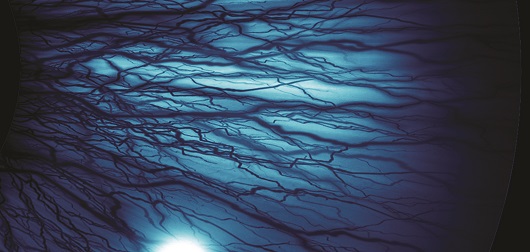With the introduction of monoclonal antibody inhibitors for all isoforms of vascular endothelial growth factor (VEGF)-A, which were first presented in September 2005 with off-label use of bevacizumab, significant anatomical and visual improvements for neovascular age-related macular degeneration (nAMD) became a reality. Following the landmark ANCHOR and MARINA trials, which showed that monthly ranibizumab injections resulted in 7.2–11.0 Early Treatment Diabetic Retinopathy Study (ETDRS) letters gained after 1 year of treatment, anti-VEGF agents became the standard of care for nAMD.1,2 The VIEW trials for nAMD studied aflibercept, a recombinant protein that fuses portions of VEGF receptors 1 and 2 to the Fc portion of human immunoglobulin G1, creating a trap for the VEGF molecules.3 In the trial, which increased the time interval between treatments to 8 weeks after a loading phase, 8.4–9.3 ETDRS letters were gained at 1 year. This further cemented the value of anti-VEGF therapy.3
Although reported results for nAMD were excellent, the adoption of anti-VEGF agents for diabetic macular oedema (DMO) was much slower. This was probably due to the slow anatomical and visual improvements noted after singular anti-VEGF injections. It took the very positive results of the RIDE/RISE trials of ranibizumab, which showed an increased vision of 8.5–9.9 ETDRS letters after 2 years, for the treatment landscape of DMO to start changing.4 Then, the VIVID and VISTA trials of aflibercept in DMO showed that between 9.4 and 11.0 ETDRS letters were gained, even with increased dosing intervals.5 With the results of these clinical trials, anti-VEGF therapy became the definitive standard of care for DMO.5 The Diabetic Retinopathy Clinical Research Network group compared aflibercept, ranibizumab and bevacizumab for the treatment of DMO in Protocol T.6 The 1–year results revealed that, in participants whose initial vision was 20/50, the aflibercept treatment arm gained 18.9 ETDRS letters at 1 year, a statistically significant increase compared with bevacizumab and ranibizumab arms, which gained 11.8 and 14.2 letters, respectively.6 Aflibercept has continued to play an increasingly prominent role in the treatment of DMO.
Although the initial responses in patients with nAMD were positive, the visual acuity improvements waned over time; this was at least in part due to the different treatment strategies employed by retina specialists. The three main treatment strategies included the pro re nata (PRN) modality, fixed interval dosing (the mainstay of clinical trials) and the treat–and–extend approach. The treat–and–extend method was widely adopted by the retina community to maximize treatment outcomes while reducing treatment burden. Some practices adopted the treat–extend–stop protocol, whereby therapy cessation was reached after two 12–week time intervals of non-activity were observed.7
With the PRN approach, many patients were found to be undertreated. This was elucidated in SEVEN UP, the extension trial of the first clinical trials ANCHOR, MARINA and HORIZON, and in CATT 5, the extension trial of CATT, which mainly use PRN treatment strategies once the trials were complete. Those studies found worse visual outcomes over time. The SEVEN-UP trial, which included 7-year outcomes in patients treated with ranibizumab in the ANCHOR, MARINA and HORIZON trials, showed a total loss of 8.6 ETDRS letters from baseline, and a total of 19 letters were lost using the best corrected visual acuity score at the end of the clinical trials.8 Similar results were found in the CATT trial when the 5–year results were published.9 The mean change in vision was a loss of 3 letters from baseline and an overall loss of 11 letters in best corrected visual acuity at the end of the trial.9
While the PRN results showed worse vision over time, Peden et al. found much better visual outcomes with fixed–interval dosing, with 12.1 ETDRS letters gained at 7 years.10 Adrean et al. found results comparable to clinical trials, such as VIEW 1 and 2, ANCHOR and MARINA, with an 8.7 letter gain at the 8–year timepoint using the treat–extend–stop approach.7 While both of these approaches led to excellent visual outcomes over the long term, multiple treatments were required to maintain these visual outcomes, with an average of 10.5 injections per year in the fixed–interval dosing study and 8.1 injections per year in the treat–extend–stop study.7,10
Notably, the Adrean et al. study switched many patients to aflibercept from other anti-VEGF agents.7 When examining the results of long-term switchers to aflibercept, Adrean et al. found that it required an average of 7.7 injections in the first year and 6.5 injections per year by year 3. Although an 8.1 ETDRS letter gain was observed after an average of 5.7 years of therapy, with aflibercept being used for the last 3 years of treatment, patients still required injections every 8 weeks on average.11 While this was an improvement from an injection every 5–6 weeks, further decreases in treatment burden were desired by patients and retina surgeons alike.11
The YOSEMITE and RHINE trials in DMO,12 and the TENAYA and LUCERNE trials in nAMD13 investigated the use of faricimab, a bispecific antibody targeting VEGF and angiopoietin 2 (ang-2). The ang-2 pathway is upregulated in some pathological conditions, resulting in increased vascular permeability; by inhibiting this pathway, vessel stability is promoted. In one of the arms of the YOSEMITE and RHINE studies (one-third of the patients) durability of treatment was examined.12 Findings showed that 71–74% of patients with DMO could be maintained with 12–16–week treatment intervals at the 1–year timepoint.12 These trials demonstrated non-inferior anatomical and visual outcomes compared with aflibercept dosed every 8 weeks. In the combined faricimab arms, there was a 10.7–11.6 ETDRS letter gain compared with a 10.3–10.9 letter gain with aflibercept for patients with DMO.12 In the TENAYA and LUCERNE nAMD trials, the average visual gain at 1 year was 5.8–6.6 compared with 5.1–6.6 ETDRS letters for aflibercept, which also demonstrated non-inferiority.13 In the nAMD trials after the loading phase, between 78% and 80% of patients on faricimab were maintained on the 12–16–week dosing intervals.13
The PULSAR and PHOTON studies demonstrated increasing durability by quadrupling the concentration of aflibercept from 2.0 mg to 8.0 mg in 0.07 mL injections in order to achieve two more half lives.14,15 Impressively, in the high-dose (HD) group of the PHOTON trial studying DMO, 91% of patients in the 12–week dosing group and 89% of patients in the 16–week group maintained their dosing intervals throughout the 48–week study.14 Combined, 93% of the HD arms were on a ≥12–week treatment interval throughout the study. Visual gains in the HD 8.0 mggroup were found to be non-inferior to the gains in the 2.0 mg–dosing group at 1 year.14
PULSAR enrolled treatment–naïve patients with nAMD.15 Overall, 83% of the aflibercept HD treatment arm remained on a dosing interval of 12 weeks or longer throughout the first year of the study, with 79% of the 12–week arm and 77% of the 16–week arm remaining on their treatment regimen.15 Visual gains in the aflibercept HD group were found to be non-inferior to those in the 2.0 mg group receiving 8–week dosing.15 Additionally, a greater proportion of the 8.0 mg aflibercept group was fluid free compared with the 2.0 mg group at 16 weeks; this key secondary endpoint was statistically significant.15
Since the durability of treatment response was successfully demonstrated by extended dosing intervals with aflibercept, it will certainly be exciting to add this new treatment to our armamentarium of options for nAMD and DMO. It will also be fascinating to see how treatment paradigms will change. Will retina specialists continue to use a treat–and–extend approach, or will fixed–interval dosing once again become the preferred treatment strategy? With the potential for only requiring three or four treatments per year, will retina specialists even attempt to stop therapy, and if so, after how many years of injections will they consider therapy cessation in nAMD and DMO?







